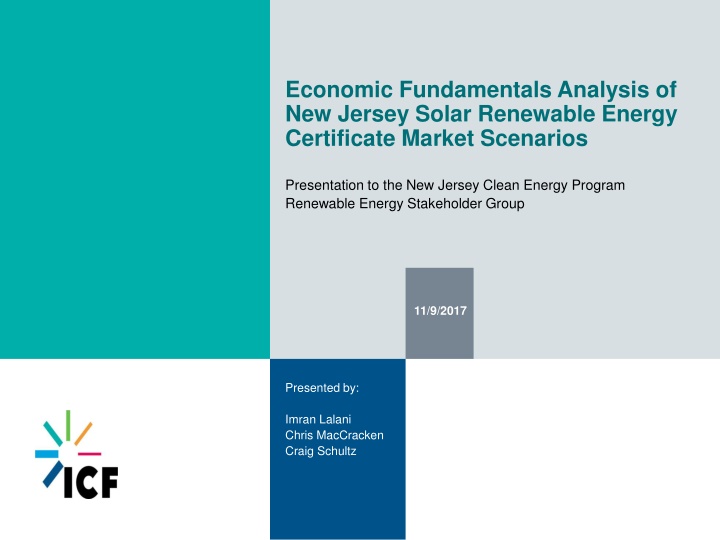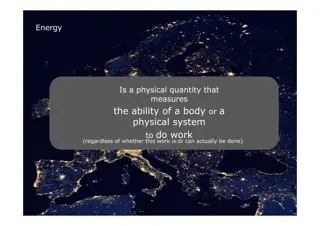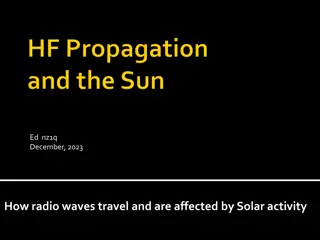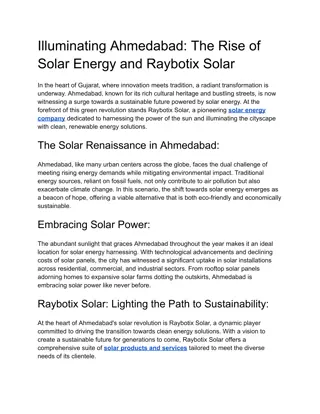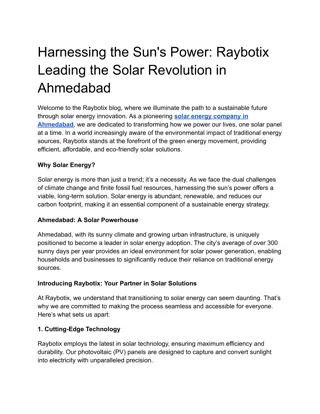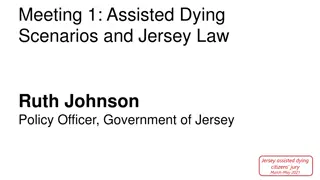Economic Fundamentals Analysis of New Jersey Solar Market Scenarios
This presentation discusses an economic fundamentals-based model developed by ICF to analyze the New Jersey solar market, considering various policy and regulatory factors. The model evaluates impacts on solar capacity builds and Solar Renewable Energy Certificate pricing over a 5-year period, providing insights into the relationship between policy inputs and market outcomes.
Download Presentation

Please find below an Image/Link to download the presentation.
The content on the website is provided AS IS for your information and personal use only. It may not be sold, licensed, or shared on other websites without obtaining consent from the author.If you encounter any issues during the download, it is possible that the publisher has removed the file from their server.
You are allowed to download the files provided on this website for personal or commercial use, subject to the condition that they are used lawfully. All files are the property of their respective owners.
The content on the website is provided AS IS for your information and personal use only. It may not be sold, licensed, or shared on other websites without obtaining consent from the author.
E N D
Presentation Transcript
Economic Fundamentals Analysis of New Jersey Solar Renewable Energy Certificate Market Scenarios Presentation to the New Jersey Clean Energy Program Renewable Energy Stakeholder Group 11/9/2017 Presented by: Imran Lalani Chris MacCracken Craig Schultz
Purpose and Background ICF developed an economic fundamentals-based (supply/demand) model to assist in evaluating the effects on the New Jersey solar market from changes in various combinations of policy and regulatory levers : Renewable Portfolio Standard (RPS) Carve-out for Solar Solar Alternative Compliance Payment (SACP) Solar Renewable Energy Certificate (SREC) Banking Period Project Qualification Life Grid Supply Subsection R (SSR) Injections The model provides a consistent framework through which to examine the direction and magnitude of impacts from possible changes in these levers on (i) solar capacity builds (MWDC) in New Jersey, and (ii) SREC pricing ($/MWh) in the State over a 5-year horizon. Intended not as a forecast, but as a useful backdrop to spur discussion on the relationship between policy and regulatory inputs and solar market outputs. The following slides summarize methods, overall findings, scenarios analyzed within the model, and scenario results. 2 Economic Fundamentals Analysis of New Jersey SREC Market .
Interpreting Economic Modeling Results The model is populated using several key assumptions. The most important assumption is that the demand for SRECs in each year must be balanced with the available potential supply of SRECs, after accounting for SREC banking behavior. If the supply of SRECs exceeds the demand for SRECs (after SREC banking activity), then: I. II. No economic solar builds are assumed to occur; and SREC prices fall to Class I REC price levels In other words, the model does not generate out of market builds, or projects that would be undertaken regardless of prevailing SREC prices and market signals The model represents a logical framework through which to gauge the magnitude and direction of market responses to policy action. It is not meant to provide point estimates nor forecasted outcomes. 3 Economic Fundamentals Analysis of New Jersey SREC Market .
Analytic Methods, Definitions, and Assumptions 4 . Economic Fundamentals Analysis of New Jersey SREC Market
Methodology: Building Blocks of the SREC Supply and Demand Framework The ICF model calculates solar economics at the individual project level across three solar customer categories utility-scale (grid supply), residential (behind-the-meter), and commercial/non-residential (behind-the-meter). This model calculates an effective SREC price given the other associated costs and revenues for each of the solar customer categories that allows solar developers/owners to meet their required rates of return. The model combines data on existing solar generation in New Jersey and solar pipeline capacity data as of 9/30/17 to establish the additional resources needed to meet the RPS solar carve-out demand in each Energy Year (EY). The eligibility to sell SRECs from the existing stock of solar generators and the SRECs generated by any new solar capacity are tracked within the model, taking into account SREC qualification life. Banking behavior is captured at a high level specifying the effective size of the bank maintained over time (as a proxy for current market trading strategies), which in turn affects the level of additional capacity necessary to meet the RPS solar carve-out obligation each year. 5 Economic Fundamentals Analysis of New Jersey SREC Market .
Methodology: Notes on Starting Condition of Modeling Current New Jersey SREC prices are higher than what the current supply/demand balance and the rates of return required for incremental solar capacity would suggest. The ability to bank SRECs up to five years, and the expectation by some market participants of a further strengthening of RPS solar carve-out requirements over time, suggest that trading behavior may be playing a role in elevating near-term SREC prices. In particular: The expectation of higher future RPS demand places upward pressure on pricing over time, ultimately approaching the solar alternative compliance payment (SACP) in the years when the market expects most players to be short. The ability to sell SRECs forward allows market participants to anticipate this event, which in turn pushes up near- term pricing. Under the Current Policy Case (Scenario 8), there is no change in RPS levels relative current law. The ICF model solves for solar capacity ( builds ) across the three customer categories (residential, commercial, and grid supply) based on relative cost, RPS demand, and the level of bank maintained by players over the period. Grid supply projects already announced are assumed to come online regardless of SREC pricing levels. Once SREC demand is fully satisfied, no further builds are assumed to take place. If the New Jersey market moves to over-compliance, SREC prices are assumed to converge to Class I REC levels ($20/MWh). 6 Economic Fundamentals Analysis of New Jersey SREC Market .
Definitions On the NJ SREC Price Trajectories graphs for the 8 Policy Scenarios (slides 20-27), there are three SREC prices that bear definition: Pure fundamentals price This reflects the SREC price needed by the marginal solar project built in a year to satisfy the SREC demand. This is also referred to as the equilibrium price (when SREC supply and demand are in equilibrium). Market clearing price This price reflects the transition (or trendline) between earlier SREC prices and the pure fundamentals price at the end of the SREC banking period. This price curve is meant to represent the price that market participants would face in each Energy Year. Current futures price This is the aggregate futures price curve based on discussions with NJ SREC market participants in late 2016 and early 2017. This reflects the then-current market view on SREC pricing over time. 7 Economic Fundamentals Analysis of New Jersey SREC Market .
Assumptions: Federal Solar Investment Tax Credit (ITC) The modeling assumes that all solar projects access the federal ITC. This is consistent with the very high level of third-party (non-host) private ownership of solar projects in New Jersey through power purchase agreements (PPAs) and other mechanisms and the observation that many of the host-owned systems will also access the ITC. The ITC is applied to the following portions of the installed cost: 30% for 2017-2019; 26% in 2020; 22% in 2021 10% in 2022 and thereafter For details, please see: https://energy.gov/savings/business-energy-investment-tax-credit-itc. The modeling does not account for the possibility that declines in the ITC will cause some acceleration in deployment (e.g., a rush to build projects at the end of 2019, 2020, or 2021). Such deployment factors are not significant in this fundamentals-driven analysis because the market is near an over-build situation (vs. RPS) already, but solar deployment timing issues may become important in other types of analysis. 8 Economic Fundamentals Analysis of New Jersey SREC Market .
Additional Assumptions: Slide 1 of 3 Name Value Source NJ-specific median price data for residential and commercial ( 500 kW) systems from Lawrence Berkeley National Laboratory (LBNL), Tracking the Sun 10. Data for grid supply systems in the Northeast in 2015, with adjustments using national year-over-year price declines to obtain 2016 prices and further adjustment from AC to DC capital costs using inverter loading ratio, from LBNL, Utility-Scale Solar 2016. https://emp.lbl.gov/sites/default/files/tracking_the_sun_10_report.pdf https://emp.lbl.gov/sites/default/files/utility-scale_solar_2016_report.pdf U.S. Department of Energy (DOE), Annual Energy Outlook (AEO), 2017 Assumptions. https://www.eia.gov/outlooks/aeo/assumptions/ $3.30 for residential; $3.00 for commercial; $1.85 for grid supply Installed Cost/kW DC in EY2017 Installed Cost Annual Rate of Decline 2% (real dollars) Applies to project installed cost minus half of the ITC, using 200% declining balance with half-year convention depreciation schedule Federal Accelerated Depreciation Internal Revenue Service. Property & Sales Taxation on Solar Project 100% Exemption New Jersey Division of Taxation. For grid supply systems, data are from LBNL, Utility-Scale Solar 2016, with conversion from AC to DC costs using inverter loading ratio in that report. Residential and commercial O&M costs from Economic Drivers of PV report for ISO-New England. Economic Drivers of PV report by ICF for ISO-New England (February 27, 2015). https://www.iso-ne.com/committees/planning/distributed-generation National Renewable Energy Laboratory (NREL) PV Watts-calculated capacity factor for a 7 kW residential roof-mount system and a 100 kW commercial open-rack system in Newark, NJ. For grid supply, used average of open-rack and single-axis tracking outputs from PV Watts for a 2,000 kW system in Newark, NJ. http://pvwatts.nrel.gov/ $33 for residential; $24 for commercial; $14 for grid supply Annual O&M Costs in EY2017 ($/kW DC) 8% of original full project installed cost with replacement in year 15 of project operation Inverter Replacement Cost 14.4% for residential; 14.5% for commercial systems; 16.0% for grid supply systems Capacity Factor (DC) in EY2017 9 Economic Fundamentals Analysis of New Jersey SREC Market .
Additional Assumptions: Slide 2 of 3 Name Value Source 2% (1/50th) improvement between 2017 and 2019. Additional 2% improvement between 2019 and 2022. Similar to the annual rate of improvement in system performance in Economic Drivers of PV report for ISO-New England. NREL, Photovoltaic Degradation Rates - An Analytical Review. https://www.nrel.gov/docs/fy12osti/51664.pdf Reflects a peak demand charge of about $7/kW-month for a commercial building, which is equivalent on a per-kWh basis to about $.0175/kWh and an assumption that PV does offset 15% of peak demand (i.e., about $.0025/kWh). Annual Improvement in Capacity Factor (for new systems) Annual Solar Performance Degradation (for existing systems) 0.5% Retail Electricity Price Adjustment for Solar Output of Commercial Projects Not Fully Offsetting Peak Demand Charges in EY2017, $/kWh Minus $0.015 Net Metering Compensation (as a % of Full Retail Price for Residential & Commercial Projects) Simplifying assumption based on approximate current practice. 100% 35% Internal Revenue Service. Federal Income Tax Rate 9% New Jersey Division of Taxation. State Income Tax Rate Informed by solar industry experience. SolarCity used a 6% discount rate in its investor communications. ICF, based on Bureau of Economic Analysis Implicit Price Deflators for Gross Domestic Product. 6% Discount Rate 2.1% Annual Inflation Rate 10 Economic Fundamentals Analysis of New Jersey SREC Market .
Additional Assumptions: Slide 3 of 3 Name Value Source Common project length for solar PPAs and for the warranty of certain solar panels. 25 Solar Project Duration (years) Wholesale and retail power prices from DOE's AEO 2017 Base Case projections for NEMS region RFCE. Power Prices Applied after SREC qualification life ends. See table below for additional detail. 20 Class I REC Price ($/MWh)* New Jersey Clean Energy Program Solar Activity Reports as of 9/30/17. http://www.njcleanenergy.com/renewable-energy/project-activity-reports/project-activity- reports Historical mix of annual residential, commercial and grid supply builds, NJ Clean Energy Solar Activity Reports: http://www.njcleanenergy.com/renewable-energy/project-activity-reports/project-activity- reports Installed Commercial, Residential, and Grid Supply Solar Capacity and Pipeline of Proposed Solar Projects Total Capacity of Each Customer Category Available to Build in each Energy Year * Assumed Class I New Jersey REC price of $20/MWh reflects current market trends based on historical data: Historical Data EY11 EY12 EY13 EY14 EY15 EY16 Class I REC Price $2.38 $4.14 $6.91 $6.83 $12.57 $15.18 Source: New Jersey Clean Energy Program RPS Report Summary 2005-2016 http://www.njcleanenergy.com/files/file/Renewable_Programs/RPS/RPS%20Comp%20EY%202016%20Combined%20Data%20All.pdf SREC Sales Treatment Residential 20% Commercial 5% Grid Supply 0% Percentage of projects that do not sell SRECs to the market Percentage of projects that receive a discount on SREC sales (i.e., sell their SRECs to an aggregator that takes a fee) Size of the discount to the face value of an SREC 80% 5% 0% 20% 5% 0% 11 Economic Fundamentals Analysis of New Jersey SREC Market .
Summary of Scenarios and Results 12 . Economic Fundamentals Analysis of New Jersey SREC Market
Solar Policy Scenario Definitions Increase Solar RPS Carve-Out Higher EY19+ Higher EY18+ Subsection R Injection N/A N/A No. Scenario SACP Qual. Life Banking Period 1 2 Updated SB2276 Original SB2276 Current Current 15 yrs 15 yrs 5 yrs 5 yrs Original SB2276 with Rate Counsel s SACP Industry Plan B Staff Alternative A Staff Alternative B Grid Supply (Subsection R) Injections No Policy Change 3 $50 lower EY18+ 15 yrs 5 yrs Higher EY18+ N/A 4 5 6 7 8 $20 lower EY18+ $50 lower EY21+ $50 lower EY21+ Current Current 15 yrs 15 yrs 10 yrs 15 yrs 15 yrs 5 yrs Higher EY18+ Higher EY21+ Higher EY21+ N/A N/A N/A N/A N/A EY19 N/A 5y til EY20, 3 yrs EY21+ 5y til EY20, 3 yrs EY21+ 5 yrs 5 yrs Detailed SREC Requirements (changes from Current Policy highlighted) 3: Original SB2276 with Rate Counsel SACP 3.00% 3.28% 3.55% 3.83% 4.10% 4.10% 4.10% 4.10% 4.10% 4.10% 4.10% 4.10% 7: No Policy Change with Subsection R Injection 3.00% 3.20% 3.29% 3.38% 3.47% 3.56% 3.65% 3.74% 3.83% 3.92% 4.01% 4.10% 6: Staff Alternative B (10 year QL) Energy Year (EY) 1: Updated SB2276 2: Original SB2276 4: Industry Plan B 5: Staff Alternative A 8: No Policy Change EY17 EY18 EY19 EY20 EY21 EY22 EY23 EY24 EY25 EY26 EY27 EY28 3.00% 3.20% 4.64% 5.30% 5.30% 5.30% 5.30% 5.14% 5.05% 4.85% 4.35% 3.74% 3.00% 3.28% 3.55% 3.83% 4.10% 4.10% 4.10% 4.10% 4.10% 4.10% 4.10% 4.10% 3.00% 3.47% 4.15% 4.50% 4.50% 4.50% 4.50% 4.50% 4.50% 4.50% 4.50% 4.50% 3.00% 3.20% 3.29% 3.38% 4.00% 4.30% 4.60% 4.90% 5.00% 5.05% 5.10% 5.30% 3.00% 3.20% 3.29% 3.38% 4.00% 4.30% 4.60% 4.90% 5.00% 5.05% 5.10% 5.30% 3.00% 3.20% 3.29% 3.38% 3.47% 3.56% 3.65% 3.74% 3.83% 3.92% 4.01% 4.10% 13 Economic Fundamentals Analysis of New Jersey SREC Market .
Directional Impacts of Potential Policy Changes Arrows depict magnitude and direction of movement in PV capacity and price impacts relative to current policy Arrows depict magnitude and direction of movement in policy lever relative to current policy Scenario Solar Banking Period Qualification Life PV Builds (Capacity) SACP SREC Pricing Carve- Out Scenario 1: Updated SB2276 Scenario 2: Original SB2276 Scenario 3: Original SB2276 with Rate Counsel s SACP Scenario 4: Industry Plan B Scenario 5: Staff Alternative A Scenario 6: Staff Alternative B Scenario 7: Current Policy + Grid Supply (Subsection R) Injection Scenario 8: Current Policy Note: This is intended not as a forecast, but as a useful backdrop to spur discussion on the relationship between policy and regulatory inputs and solar market outputs. 14 Economic Fundamentals Analysis of New Jersey SREC Market .
Net Impacts of Policy Levers Under Scenarios Examined Lever 1 RPS Higher EY19+ Lever 2 Lever 3 Lever 4 Policy Scenario Impact on SREC pricing Impact on Solar Builds Scenario 1: Updated SB2276 Higher demand leads to higher prices as higher cost builds selected. Highest level of RPS demand pushes up total builds. Scenario 2: Original SB2276 RPS Higher EY18+ Higher demand leads to higher prices as less economic builds selected. Higher RPS demand pushes up total builds. Scenario 3: Original SB2276 with Rate Counsel s SACP SACP $50 Lower EY18+ RPS Higher EY18+ No additional impact relative to Scenario 2. No additional impact relative to Scenario 2. High level of RPS demand incents large buildout. Builds taper since EY20 and EY21 RPS percentages are equal. SACP $20 Lower EY18+ Scenario 4: Industry Plan B RPS Higher EY18+ Higher RPS requirement pushes up SREC price trajectory. 3 yr Banking Period EY21+ 3 yr Banking Period EY21+ Smoother buildout of resources as the system builds forward in anticipation of growing RPS demand. SACP $50 Lower EY21+ Scenario 5: Staff Alternative A RPS Higher EY21+ SREC prices remain well above Class I levels throughout forecast period. Shorter qualification life leads to higher SREC prices (fewer years in which to recoup project costs through SREC payments). SACP $50 Lower EY21+ Qualifica- tion Life 10 yrs Scenario 6: Staff Alternative B RPS Higher EY21+ Builds mirror Scenario 5, since RPS demand identical. Injection of 67 MW of SSR capacity in EY18 is enough to drive down SREC pricing to make Behind the Meter PV uneconomic. Scenario 7: Current Policy + Grid Supply (Subsection R [SSR]) Injection SSR Injection that makes residential uneconomic Prices move lower in response to grid supply injections. Scenario 8: Current Policy Prices decline through EY21-22 Builds decline through EY21-22 15 Economic Fundamentals Analysis of New Jersey SREC Market .
How do the Policy Levers Impact the Market? Market Impact Policy Lever SREC Price Solar Builds Explanation Value of banked allowances are reduced. If no change in total level of expected RPS demand, then no impact in solar capacity (builds). No impact (within SACP ranges analyzed) Reduces near- term SREC price Lower SACP Higher RPS demand drives higher builds. This can result in more expensive resources needing to be built, leading to higher SREC prices. Higher Solar Carve- Out % Increases SREC prices Increases solar builds Shorter banking life reduces the ability to bank in anticipation of a short market in the future. There is also less flexibility around trading strategies within the market, which pushes the system towards equilibrium sooner. Anticipated SREC demand is unaffected, but ability to bank over-compliance in current period into the future is limited. SREC price equilibrium reached sooner No impact / limits near-term over- builds Shorter Banking Period Shorter qualification life results in solar projects needing to recover their costs over fewer years of SREC payments, which pushes up implied SREC prices. Over time, builds become ineligible to generate SRECs sooner, and must be replaced by new capacity, necessitating higher buildouts. Potentially increases longer-term solar builds Shorter Increases SREC prices Qualification Life Injection of grid supply solar projects displaces behind- the-meter projects. SREC prices recover quickly after injection ends. Grid Supply (SSR) Injections Decreases SREC prices Modest reduction in capacity 16 Economic Fundamentals Analysis of New Jersey SREC Market .
Scenario Results By Year: Estimated New Jersey SREC Prices ($/MWh) 3: Original SB2276 with Rate Counsel SACP 178 155 127 20 20 7: Current Policy with SSR Injection 1: Updated SB2276 2: Original SB2276 4: Industry Plan B 5: Staff Alternative A 6: Staff Alternative B 8: Current Policy Year 2017-18 2018-19 2019-20 2020-21 2021-22 187 168 146 153 96 178 155 127 20 20 175 150 122 20 20 175 150 120 128 125 187 168 142 152 149 175 104 119 83 82 175 150 119 83 82 Note: If NJ SREC program is oversupplied, SRECs are assumed to be sold into the wider RPS market, and prices reach Class I REC levels ($20/MWh). 17 Economic Fundamentals Analysis of New Jersey SREC Market
Scenario Results By Year: Estimated New Jersey Solar Builds (MWDC) Projected Behind The Meter Solar Installations: 3: Original SB2276 with Rate Counsel SACP 282 217 95 0 0 7: Current Policy with SSR Injection 1: Updated SB2276 2: Original SB2276 4: Industry Plan B 5: Staff Alternative A 6: Staff Alternative B 8: Current Policy Year 2017-18 2018-19 2019-20 2020-21 2021-22 300 367 386 122 0 282 217 95 0 0 295 289 140 0 0 282 84 104 116 135 282 84 104 116 135 282 0 39 0 0 282 84 36 0 0 Projected Grid Supply Installations (Including Subsection R): 3: Original SB2276 with Rate Counsel SACP 63 25 15 3 0 7: Current Policy with SSR Injection 1: Updated SB2276 2: Original SB2276 4: Industry Plan B 5: Staff Alternative A 6: Staff Alternative B 8: Current Policy Year 2017-18 2018-19 2019-20 2020-21 2021-22 88 68 83 71 12 63 25 15 3 0 88 68 83 3 0 51 37 15 28 68 51 37 15 28 68 51 104 15 7 8 51 37 15 7 8 Changing SREC demand levels (i.e., solar carve-out levels in the RPS) are the main drivers of differential builds under the different scenarios. The updated SB2276, Staff Alternative A, and Staff Alternative B result in continued signals for incremental capacity additions over the forecast period, while the other scenarios move to over-compliance in EY21. Under the Current Policy Scenario, the market moves towards over-compliance in EY21 (2020-21). This, in turn, results in very small incremental need for solar generation to meet SREC demand and maintaining the bank, and so very small incremental economic PV additions occur in EY21+. 18 Economic Fundamentals Analysis of New Jersey SREC Market
Results for Each Defined Policy Scenario 19 . Economic Fundamentals Analysis of New Jersey SREC Market
Results for Scenario 1: Updated SB2276 The recently-proposed SB2276 features a significant increase in RPS demand through EY20 and flat/tapering standards thereafter. This is reflected in the build pattern and price trajectory of this scenario the elevated levels of SREC demand result in strong continued solar installations through EY21, before dropping sharply in EY22. EY22 builds only serve to replace degraded capacity and capacity beyond its qualification life. SREC prices remain strong throughout the forecast period, reflecting the need for incremental solar capacity. The downward SREC price trajectory reflects the changing build mix, increasing power prices, and improving solar cost and performance assumptions. 20 Economic Fundamentals Analysis of New Jersey SREC Market .
Results for Scenario 2: Original SB2276 The originally-proposed SB2276 features a more modest increase in RPS demand through EY21 and flat standards thereafter. As compared to current policy, the near term builds are elevated. However, the flat standards in EY21+ mean that there is limited need for incremental solar capacity, and prices converge to Class I REC levels as a result. 21 Economic Fundamentals Analysis of New Jersey SREC Market .
Results for Scenario 3: Original SB2276 with Rate Counsel s SACP This scenario features a lower SACP in EY18 onwards, but is otherwise identical to Scenario 2. Under Scenario 2, there was sufficient incremental solar capacity available at SREC values below the original SACP levels. Since the updated SACP trajectory used in this scenario is higher than the projected SREC values under Scenario 2, the updated SACP value does not have an impact on SREC pricing. Since the SREC demand is unchanged between Scenario 2 and Scenario 3, projected capacity additions are also unchanged. 22 Economic Fundamentals Analysis of New Jersey SREC Market .
Results for Scenario 4: Industry Plan B This scenario features an SREC target between the original SB2276 and the updated SB2276. The solar carve-out in the RPS ramps to 4.5% by EY20 and remains flat thereafter. This is reflected in the build and pricing pattern builds remain strong through EY20, as do SREC prices. Lack of growth in SREC demand in EY21 reduces the need for incremental capacity, and SREC pricing falls to Class I REC levels as a result. 23 Economic Fundamentals Analysis of New Jersey SREC Market .
Results for Scenario 5: Staff Alternative A This scenario features higher RPS levels relative to current policy beginning in EY21 that continue to grow after the forecast period. As a result of the growing SREC demand over time, the market continues to require incremental solar capacity over the forecast period, which means that SREC pricing remains higher than the current policy scenario. Solar capacity additions continue to occur smoothly throughout the forecast period. 24 Economic Fundamentals Analysis of New Jersey SREC Market .
Results for Scenario 6: Staff Alternative B This scenario is identical to Staff Alternative A, except it features a 10-year Qualification Life as compared to a 15-year Qualification Life under Staff Alternative A. The Qualification Life is the period for which a particular project is eligible to generate SRECs. A shorter Qualification Life therefore means a shorter period of SREC payments for a given solar project. The shorter Qualification Life pushes up SREC prices, since projects must recover their costs over a shorter period. Solar capacity additions are identical to Staff Alternative A since the underlying SREC demand is identical. 25 Economic Fundamentals Analysis of New Jersey SREC Market .
Results for Scenario 7: Current Policy with Grid Supply (Subsection R) Injection Scenario 7 is identical to current policy (Scenario 8), except for an injection of 67 MW of Subsection R (SSR) capacity, projected to come online in EY19. The higher performance (capacity factor) and lower cost of grid supply solar relative to behind the meter solar means that the injection of SSR capacity tends to tamp down SREC prices in EY19. The injection of this level of SSR capacity is also enough to displace completely the economic residential and commercial solar installations that would otherwise have occurred in EY19. Results in EY20+ nearly match Scenario 8 results, as no further injections of SSR are assumed to occur. 26 Economic Fundamentals Analysis of New Jersey SREC Market .
Results for Scenario 8: Current Policy Market participants anticipate policy action that will increase SREC demand above levels dictated by current policy, which prompts the maintenance of a healthy SREC bank in anticipation of future demand. If policy change does not occur (i.e., this scenario), the market approaches oversupply and builds and SREC prices decline as a consequence. The SREC market transitions towards economic fundamentals-based pricing levels by EY20 as participants reconcile to the existing policy design. The model does not add incremental capacity beyond levels needed to meet demand and banking behavior. Limited incremental builds occur in EY21-22 as a result. 27 Economic Fundamentals Analysis of New Jersey SREC Market .
Illustrative Investment Returns by Project Type 28 . Economic Fundamentals Analysis of New Jersey SREC Market
Illustrative Investment Rate of Return by Solar Project Type Rate of Return (%)* SREC Price ($/MWh) Residential Commercial Grid Supply 0 -15% -24% -26% 50 -9% -18% -14% 100 -3% -11% -2% 150 3% -4% 10% 200 9% 2% 21% 250 15% 9% 33% * Note: The rate of return is for a representative solar build in EY17 that receives the specified SREC payment for every MWh of generation for the first five years of operation (and Class I REC prices thereafter). The five years of SRECs in this calculation reflects a duration that project owners may use to hedge (lock in) SREC prices to secure financing, though the owners can sell their project SRECs into the market for 15 years. The earlier scenarios in this presentation used an SREC qualification life of 15 years unless otherwise noted (for Scenario 6). 29 Economic Fundamentals Analysis of New Jersey SREC Market .
